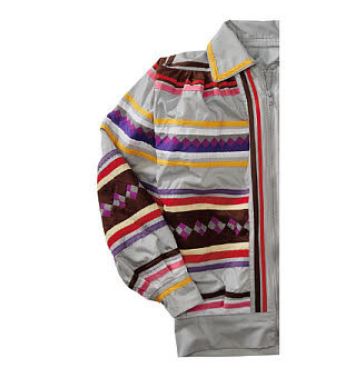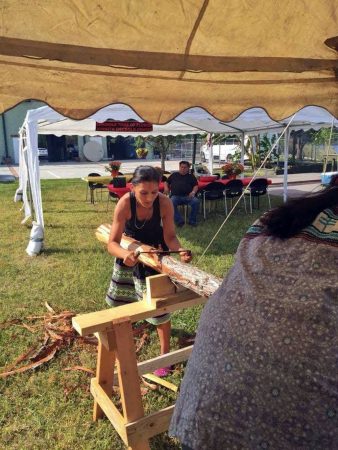A passionate ceramist, sculptor and multimedia artist, Naples-based Seminole artist Jessica Osceola looks to her multicultural roots to meld traditional Native American themes and materials with contemporary art. Her work is infused with traditional tribal patterns and patchwork, which her grandma (a 19th-century Seminole leader, artist, and activist) taught her to sew when she was a small girl. Not only were we lucky enough to have her adapt one of these classic Seminole patterns into a bold and playful Tea print, we had the chance to chat with the artist herself and get a glimpse into her colorful world.
What was it like growing up in a Seminole village in Florida?
Growing up in a Seminole village was focused very heavily on family. I lived with my two grandmothers, mother, father, sisters, uncle, and there were always cousins and visitors. My mother is American and my father is Seminole. I grew up in a village, but I was firmly rooted in modern culture. In school, I tended to feel like the odd one out because of my lifestyle—living on a well pump, fishing, raising our meat or hunting was out of the norm.
What are some of your favorite customs and traditions of the Seminole culture?
My favorite thing to do with my grandmother was making biscuits over the open fire in a cast iron dutch oven. My favorite moments are when women gather to cook over the open flame or sew together or style each others hair in traditional ways. Those moments are why the culture thrives. Because when mothers, and daughters, and grandmothers get together we share our secrets. It’s beautiful for us and for our generations to come.
What do you love most about creating art?
The ability to express colors, moods, innovation, overcoming obstacles, and problem-solving. In many cases for me, art is more about the process than the result.
Can you describe your artistic process?
I generally start with an inspiration. From there I develop sketches and often models to further develop the idea. In sewing, I lay out my colors and textures first, and then begin to piece together the work. In my contemporary sculptures, color comes last and form is first.
Do you have a favorite artist tool, something that’s essential to your workflow?
In all of my work, the ruler rules! Patchwork is very mathematical and so is sculpting the human figure. Either way, a straight line and form of measurement is essential.
I read that creativity runs in your family. What kind of role did art play in your upbringing?
My mother designs landscapes and natural environments—in her family there are doll makers and seamstresses that go way back. My father builds traditional Seminole homes called Chickee. He also draws and builds furniture—he is great at woodwork. On my father’s side are Seminole doll makers, sweet grass basket weavers, jewelers, and lots of seamstresses.
Much of your current artwork is centered on self-portraiture. What feelings, emotions or messages are you looking to convey? How do you convey feeling—is it through use of color, facial expression?
I am looking to open a conversation about identity. I convey cultural and social references through expression and color. I touch on some cultural taboos and blend both a classical reference to nudity and symbols of Seminole art.
Can you describe the style of traditional Seminole art? What are some common themes/motifs, and what aesthetically speaking sets their artwork apart from tribes in other regions in the United States?
Hmm…in a brief summary:
-Clothing comes out of function, trade items, and environment
-Patchwork has evolved to become a very competitive art form among tribal members
– Basketry comes out of tourism
– Dolls, like basketry, are made with local materials
Who are some of the artists that have influenced your artistic style over the years?
Cindy Sherman, Hans Holbein, Karie Osceola, and Christina Billie
How has your environment and cultural upbringing inspired your work?
Culture is the people itself. The movements in society inspire me. Often times I do not go with the trends; I tend to collect all the information from past and present and create something that seems timeless.
What kind of impact are you hoping your work has on the community? What story are you trying to convey?
It takes a community for these art forms to exist. It is up to the social groups to get the legacy of their designs to remain. These designs do not belong to any one of us, but the whole culture itself.
If you could travel anywhere in the world for inspiration, where would you go?
For me inspiration comes in the form of textures and colors in architecture and natural landscapes of the world. I love the rhythm of people and different cultures and societies. I love travel so I cannot think of one place…so the world!




